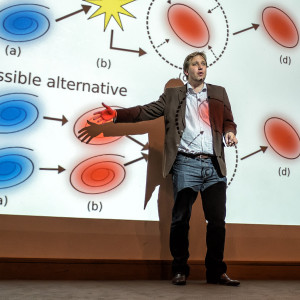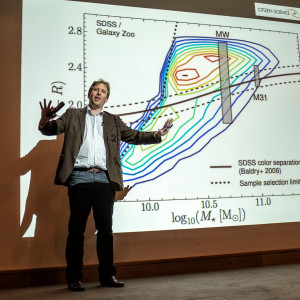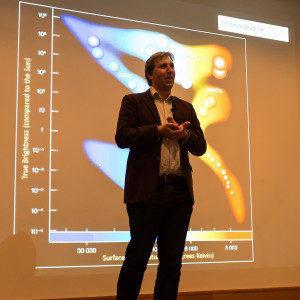November 18, 2013
Is the Milky Way Special?
Dr Chris Lintott
Report by: Chris Sutcliffe
Chris Lintott needs little introduction to Flamsteed members. He is a co-presenter on the BBC Sky at Night programme and, as a trustee of the National Maritime Museum, a regular visitor to the Flamsteed.
His talk to the Flamsteed was about trying to answer a rather unusual question. Is our own Milky Way galaxy special in comparison to other galaxies in the universe? Over the last few hundred years, we’ve asked the questions “is the Earth special?” or “is the Sun special?” The debate around the answers to these questions is still going on.
Pretty much as soon as people started using telescopes it was possible to resolve the milky glow of the Milky Way into a myriad of stars. It was only then that we realised that the Milky Way was made up to stars. Structures outside of our Milky Way, such as spiral galaxies, were not recognised as separate galaxies, until the observations of novae confirmed the existence of galaxies external to the Milky Way.
If we want to understand the structure of our own galaxy, we can image the galaxy in multiple wavelengths of light. We can see that the galaxy is a thin strip with a bulge of stars in the centre. Based on these observations, our best guess of the structure of our galaxy is that:
- It is a thin disc, just a few thousand light years thick;
- The galaxy has two (or possibly four, or many) spiral arms (depending on how you count them), probably with a ‘bar’ in its centre;
- The spiral arms have complex structure and are blue in colour;
- Star formation takes place in the spiral arms.
The Milky Way turns out to have a fairly typical mass for a galaxy.
Chris produced a graph showing that the greater the distance of a galaxy, the higher the velocity at which it is moving away. From the diagram, it is possible to determine Hubble’s Law. This states that the farther away a galaxy is, the faster it is receding from us. Of course, if you run this model backwards, you end up with the Big Bang. This means that the galaxies are isolated systems, but they are all formed from the same hot, dense source.
Based on various sky surveys, in particular the Sloan Digital Sky Survey, we can see that is not unusual that our galaxy is spiral (about a third to a half are spiral), and its colour is relatively normal.
Chris then focused upon the Hertzsprung-Russell diagram.
When astronomers were trying to understand the stars, they focused on the things that they could measure… the colour and the brightness. When you plot this on a diagram, it is possible to determine the path of a stars life. It turns out that there is an equivalent for galaxies – a colour-magnitude diagram for galaxies.
When you plot this data, you find that galaxies are split into two categories. About half the galaxies live on the ‘red’ sequence, with a ‘blue’ sequence containing galaxies that are mostly fainter. In between, there is a less populated area known as the ‘green valley’. Galaxies can move around this diagram, particularly when collisions between galaxies take place, which we know will happen to the Milky Way at some time in the next few billion years when it collides with the Andromeda Galaxy.
The Milky Way and Andromeda Galaxies are in the ‘blue’ cloud area. When they collide, they will form a slightly brighter galaxy, but will also trigger star formation, resulting in a slightly bluer galaxy. As the big blue stars only last for a few hundred million years, the colour of the galaxy will then move to the ‘red’ sequence.
It is here that we find the first reason why the Milky Way may be special. Galaxies the size of the Milky Way should have one of these collisions every billion years or so. The Milky Way does not seem to have had one of these mergers for 4-5 billion years, and we are not due another for 4 billion years. We have therefore had a very quiet period in our galaxy’s history.
The Milky Way is hard to study because we are in it! We can’t easily determine the colour of our galaxy, but we can have a good guess based on the light from our galaxy that we observe on Earth. From these observations, it appears we may be in the ‘green valley’, which is unusual for a spiral galaxy. It may not stay that way for long because we have two small companion galaxies, the large and small Magellanic Clouds. As the Milky Way consumes them over the next few hundred million years, this could trigger star formation, making our galaxy bluer in colour.
The Milky Way’s position on the colour-magnitude diagram would suggest, when compared to other galaxies of the same type, that it should be an active galaxy with a growing black hole. However, the Milky Way is not as active as it should be, which is another reason why it may be special. However, astronomers have discovered signs that the Milky Way may have been more active only a few thousand years ago. Observations of Fermi Bubbles in our own galaxy suggest that the black hole at the centre may switch itself on and off on very short timescales. So it may be that the Milky Way is not abnormally quiet… we’ve just caught it at an ‘off’ phase… and it may just be what Milky Way sized galaxies do.
There is a third and final way as to why our galaxy might be special. Chris showed a slide indicating that the universe is made up of:
- Dark energy 68.3%
- Dark matter 26.8%
- Ordinary matter 4.9%
Gravity is an attractive force, which should be slowing down expansion of the universe. However, it is apparent that the expansion of the universe is speeding up, based on the observations of type 1A supernovae. Distant supernovae appear fainter than they should be, so must be further away than they should be, meaning that the universe must have expanded more than we thought. This accelerated expansion has been explained by introducing the concept of dark energy, which is a force that accelerates the expansion of the universe.
However, the concept of dark energy can be removed if we can claim that the Milky Way is special… by imagining that we live in a part of the universe that it is relatively empty compared to other parts… an area where gravity is less important. In this case, when we look at the rest of the universe, we start to look at areas that are denser and where gravity is more important. In those areas, gravity will have slowed down the expansion more. So when we plot a graph along the line of sight, we would see acceleration in the expansion of the universe.
Does this stand up to observations? We need a map of the universe with the Milky Way in the centre of a relative void… a low density region. If this were the case, we can get rid of dark energy. A very interesting thought. However, it is not quite that simple. Observations from the Hubble Space Telescope seem to rule this out, at least if we want to retain our theories on the expansion and evolution of the universe. We need more observations to confirm this and it may be that we have to rewrite our current theories.
The Gaia satellite, launched just before Christmas, may give us the opportunity to do this. It will map the nearest billion stars to us and, with that sort of information, we should be able to unpick the history of the Milky Way. It is a machine for finding out new ways for which the Milky Way is special.
We were privileged to enjoy this fascinating talk from such a great authority on the subject.
Pictures from the Evening (by Mike Meynell and Sumitra Sri Bhashyam):
Posted under: Flamsteed, Flamsteed Lecture, Meeting Report










You must be logged in to post a comment.